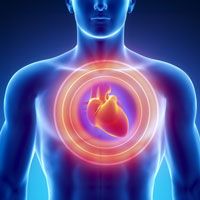Gout Is Associated with Heart Dysfunction
Study results suggest that gout itself and not hyperuricemia alone is associated with left ventricular diastolic dysfunction and left atrial volume enlargement.

A study in Arthritis Research & Therapy suggests that gout itself‑‑and not hyperuricemia alone‑‑is associated with left ventricular (LV) diastolic dysfunction and left atrial volume enlargement.
The finding is important, because the connections between gout and cardiovascular events are well known and thoroughly studied, but still not well-understood. Many studies, including the seminal Framingham heart study among many others, have reported elevated uric acid (UA) as a risk factor for coronary heart disease, atrial fibrillation, and cardiac mortality. In addition, hyperuricemia is a demonstrated predictor of poor prognosis in acute stroke and congestive heart failure. Elevated UA is also associated with LV hypertrophy in patients without underlying cardiovascular disease and with diastolic dysfunction in patients with heart failure. It is known that hyperuricemia accelerates the occurrence and worsening of cardiovascular disease due to LV remodeling. But it has remained unclear whether hyperuricemia is the sole contributor to organic heart remodeling in patients with gout.
The current study involved 173 patients without hyperuricemia, with hyperuricemia, or with gouty arthritis, who underwent echocardiographic examinations. Asymptomatic hyperuricemia was defined as UA ≥7 mg/dL. The diagnosis of gouty arthritis was made according to the American College of Rheumatology (ACR)/Wallace criteria. The patients were divided into tertiles based on the following serum UA levels: 1) serum UA ≤ 6.5 mg/dL (n = 54), 2) serum UA >6.5 to ≤8.5 mg/dL (n = 59), and 3) serum UA > 8.5 mg/dL (n = 60).Patients underwent a comprehensive Doppler-echocardiography examination to evaluate LV volume, systolic and diastolic function, and left atrial (LA) volume.
LV diastolic parameters were not significantly different between the three groups. Among the population being studied, 108 individuals received a gout diagnosis. Gout patients had greater LV end-systolic dimensions (27.08 ± 4.38 mm, p = 0.006), higher LV mass index (107.18 ± 29.51 g/m2, p < 0.001), higher E/Em (10.07 ± 2.91, p = 0.008), and larger maximal LAVi (16.96 ± 7.39 mL/m2, p < 0.001) than patients without gout. The prevalence of moderate to severe LV diastolic dysfunction was higher in patients with gout (23%, p = 0.02).
“The major finding of this study was that gout impacts LV diastolic dysfunction and LA volume enlargement,” the study authors noted. “Accumulating evidence from previous studies supports the existence of a repetitive and progressive state of inflammatory activation that is strongly associated with the progression of ventricular diastolic dysfunction and characterized by the intense release and activation of circulating cytokines. Whether hyperuricemia alone contributes to LV organic and functional remodeling in gout patients remains contentious. The current study is the first to evaluate LV diastolic function in gout patients and to determine the role of chronic gout-related inflammation in LV diastolic dysfunction remodeling.”